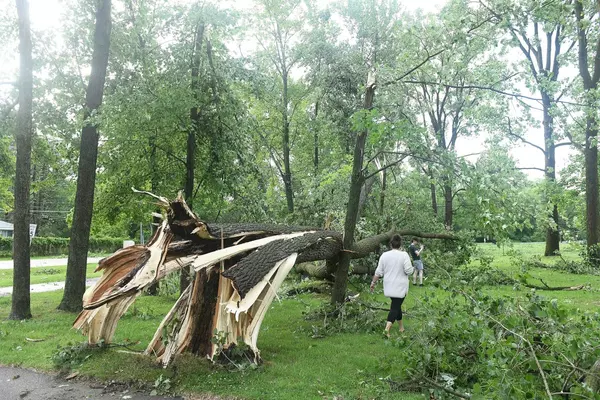The recent tornado tragedies in Livonia and Maryland have left a trail of devastation that underscores the unpredictable and destructive power of nature. Livonia, confronted by an EF1 tornado with winds reaching 95 mph, saw significant damage to homes and infrastructure, while Maryland experienced severe structural damage and numerous casualties. These events have highlighted the urgent need for effective emergency response protocols and community resilience planning. As rescue operations continue and damage assessments begin, the broader implications for disaster preparedness across the United States come into sharp focus. What steps will be taken to mitigate such future risks?
Read Related Article:
- Maryland Hit by Devastating Tornado Outbreak
- Tornadoes Devastate Communities Near Washington, D.C
- Michigan Town Left Unwarned Before Deadly Tornado
- Storms Wreak Havoc: Montgomery County Residents’ Resilience
- Tornado Tragedy Strikes Livonia and Maryland, Spreading Devastation
Key Takeaways

- Livonia experienced an EF1 tornado with 95 mph winds, causing significant damage to homes and uprooting trees.
- Montgomery County, Maryland faced a destructive tornado, resulting in five casualties and widespread structural damage.
- Emergency services in Maryland performed door-to-door assessments and rescued individuals trapped in collapsed structures.
- Livonia’s community support was strong, with neighbors and local organizations providing aid despite the lack of warning sirens.
- Tornadoes across the U.S. have led to nationwide efforts for immediate relief and long-term recovery in multiple states.
Livonia Tornado Incident
The Livonia tornado incident was marked by a tragic loss and significant structural damage as an EF1 tornado, with peak wind speeds reaching 95 mph, struck several neighborhoods, uprooting trees and damaging houses.
The aftermath of the Livonia tornado has been profound, as the community grapples with the death of a 2-year-old boy and critical injuries sustained by his mother. The community support has been palpable, with neighbors and local organizations rallying to provide aid to affected families.
Emergency services have been working diligently to clear debris and restore safety. This collaborative effort underscores the resilience and solidarity of the Livonia community during such a challenging period, emphasizing the importance of swift and coordinated disaster response.
Tornado Details in Livonia
Livonia experienced an EF1 tornado with a peak wind speed of 95 mph, which traveled over five miles, causing significant damage to trees and houses. The livonia tornado details indicate that the storm’s ferocity led to the uprooting of mature trees and extensive structural damage to residential properties.
The tornado’s path left a trail of destruction, with multiple homes suffering roof damage and broken windows. Livonia’s warning sirens were not activated due to the National Weather Service’s inability to detect the spin-up storm in time. As a result, the community was caught off guard, exacerbating the storm damage.
Fire Department Chief Robert Jennison reported that emergency response teams worked tirelessly to clear debris and assist affected residents.
Maryland Tornado Impact
In Montgomery County, Maryland, a tornado caused significant structural damage and injuries, with emergency workers responding to collapsed buildings and large fallen trees. The severe weather event resulted in five casualties, including one individual who sustained traumatic injuries.
Numerous homes were damaged, particularly from a large tree that fell on a single-family residence. The tornado also led to widespread power outages, compounding the difficulties faced by residents. Immediate damage assessments and rescue operations were initiated, highlighting the extent of destruction.
Power restoration efforts are ongoing, while structural engineers are evaluating the compromised buildings. The community remains on high alert as authorities continue to address the aftermath and ensure public safety.
Emergency Response in Maryland
Effective emergency response efforts in Maryland demonstrated the critical coordination between fire, rescue services, and structural engineers in the wake of the tornado.
Emergency workers swiftly mobilized to conduct door-to-door assessments, ensuring that all affected residents received timely assistance.
The immediate focus was on locating and extricating individuals trapped in collapsed structures in Gaithersburg. This included the meticulous removal of a large tree that had fallen on a single-family house, causing significant injuries to five individuals.
Emergency personnel efficiently facilitated the transportation of the injured to nearby hospitals for urgent medical treatment.
These efforts highlight the importance of integrated emergency response protocols and the readiness of Maryland’s teams to manage complex disaster scenarios.
Tornadoes Across the US
The recent emergency response efforts in Maryland underscore a broader pattern of tornado activity impacting multiple states across the U.S., leading to widespread casualties, injuries, and significant structural damage.
Tornadoes have ravaged states including Michigan, Maryland, Kentucky, and Texas, necessitating a coordinated national response to address the multifaceted challenges. Federal agencies, alongside local authorities, are mobilizing resources for immediate relief and long-term recovery.
Community support remains pivotal as affected areas grapple with power outages, infrastructure damage, and displaced families. In Livonia, Michigan, the lack of advance warning exacerbated the devastation, highlighting the need for improved detection systems.
Nationwide, the focus is on enhancing resilience through better preparedness and robust emergency protocols.